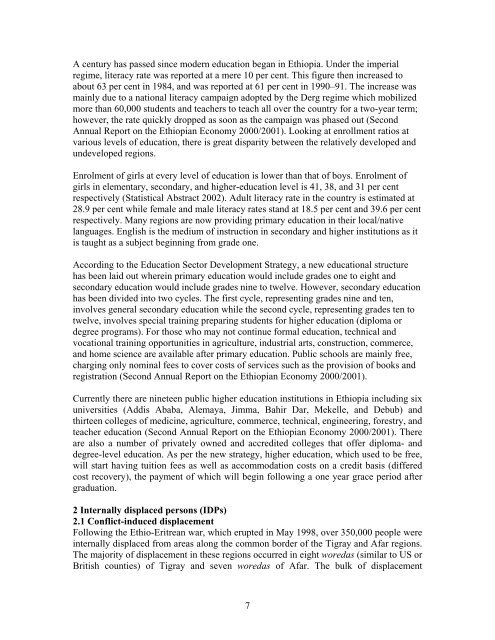FMO Country Guide: Ethiopia - Forced Migration Online
FMO Country Guide: Ethiopia - Forced Migration Online
FMO Country Guide: Ethiopia - Forced Migration Online
You also want an ePaper? Increase the reach of your titles
YUMPU automatically turns print PDFs into web optimized ePapers that Google loves.
A century has passed since modern education began in <strong>Ethiopia</strong>. Under the imperial<br />
regime, literacy rate was reported at a mere 10 per cent. This figure then increased to<br />
about 63 per cent in 1984, and was reported at 61 per cent in 1990–91. The increase was<br />
mainly due to a national literacy campaign adopted by the Derg regime which mobilized<br />
more than 60,000 students and teachers to teach all over the country for a two-year term;<br />
however, the rate quickly dropped as soon as the campaign was phased out (Second<br />
Annual Report on the <strong>Ethiopia</strong>n Economy 2000/2001). Looking at enrollment ratios at<br />
various levels of education, there is great disparity between the relatively developed and<br />
undeveloped regions.<br />
Enrolment of girls at every level of education is lower than that of boys. Enrolment of<br />
girls in elementary, secondary, and higher-education level is 41, 38, and 31 per cent<br />
respectively (Statistical Abstract 2002). Adult literacy rate in the country is estimated at<br />
28.9 per cent while female and male literacy rates stand at 18.5 per cent and 39.6 per cent<br />
respectively. Many regions are now providing primary education in their local/native<br />
languages. English is the medium of instruction in secondary and higher institutions as it<br />
is taught as a subject beginning from grade one.<br />
According to the Education Sector Development Strategy, a new educational structure<br />
has been laid out wherein primary education would include grades one to eight and<br />
secondary education would include grades nine to twelve. However, secondary education<br />
has been divided into two cycles. The first cycle, representing grades nine and ten,<br />
involves general secondary education while the second cycle, representing grades ten to<br />
twelve, involves special training preparing students for higher education (diploma or<br />
degree programs). For those who may not continue formal education, technical and<br />
vocational training opportunities in agriculture, industrial arts, construction, commerce,<br />
and home science are available after primary education. Public schools are mainly free,<br />
charging only nominal fees to cover costs of services such as the provision of books and<br />
registration (Second Annual Report on the <strong>Ethiopia</strong>n Economy 2000/2001).<br />
Currently there are nineteen public higher education institutions in <strong>Ethiopia</strong> including six<br />
universities (Addis Ababa, Alemaya, Jimma, Bahir Dar, Mekelle, and Debub) and<br />
thirteen colleges of medicine, agriculture, commerce, technical, engineering, forestry, and<br />
teacher education (Second Annual Report on the <strong>Ethiopia</strong>n Economy 2000/2001). There<br />
are also a number of privately owned and accredited colleges that offer diploma- and<br />
degree-level education. As per the new strategy, higher education, which used to be free,<br />
will start having tuition fees as well as accommodation costs on a credit basis (differed<br />
cost recovery), the payment of which will begin following a one year grace period after<br />
graduation.<br />
2 Internally displaced persons (IDPs)<br />
2.1 Conflict-induced displacement<br />
Following the Ethio-Eritrean war, which erupted in May 1998, over 350,000 people were<br />
internally displaced from areas along the common border of the Tigray and Afar regions.<br />
The majority of displacement in these regions occurred in eight woredas (similar to US or<br />
British counties) of Tigray and seven woredas of Afar. The bulk of displacement<br />
7
















